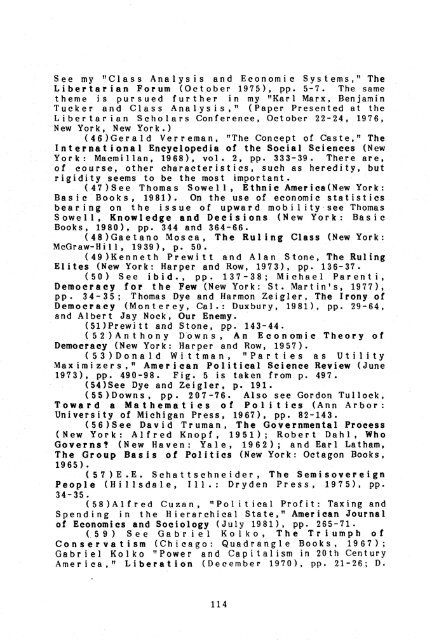Freedom, Society, and State - Ludwig von Mises Institute
Freedom, Society, and State - Ludwig von Mises Institute
Freedom, Society, and State - Ludwig von Mises Institute
Create successful ePaper yourself
Turn your PDF publications into a flip-book with our unique Google optimized e-Paper software.
See my "Class Analysis <strong>and</strong> Economic Systems," The<br />
Libertarian Forum (October 1975), pp. 5-7. The same<br />
theme is pursued further in my "Karl Marx, Benjamin<br />
Tucker <strong>and</strong> Class Ana lys is," (Paper Presented at the<br />
Libertarian Scholars Conference, October 22-24,1976,<br />
New York, New York.)<br />
( 4 6 ) Gera 1 d Ve r reman, "The Con c e p t 0 f Ca s t e ," The<br />
International Encyclopedia of the Social Sciences (New<br />
York: Macmillan, 1968), vol. 2, pp. 333-39. There are,<br />
of course, other characteristics, such as heredity, but<br />
rigidity Beems to be the most important.<br />
( 47 ) See Thoma s S owe I I, E thn i c Amer i ca (N ew Yor k :<br />
Bas i c Boo k s, 19 81 ) • On the use 0 f e con om i csta tis tics<br />
bearing on the issue of upward mobility-see Thomas<br />
Sowell, KnOWledge <strong>and</strong> Decisions (New York: Basic<br />
Books, 1980), pp. 344 <strong>and</strong> 364-66.<br />
(48)Gaetano Mosca, The Ruling Class (New York:<br />
McGraw-Hill, 1939), p. 50.<br />
(49)Kenneth Prewitt <strong>and</strong> Alan Stone, The Ruling<br />
Elites (New York: Harper <strong>and</strong> Row, 1973), pp. 136-37.<br />
(50) See ibid., pp. 137-38; Michael Parenti,<br />
Dern 0 c r a c y for the Few ( New Yo r k: St. Ma r tin's, 19 7 7 ) ,<br />
pp. 34- 35; Thomas Dye <strong>and</strong> Harmon Zeigler, The Irony of<br />
Dem0 c r a c y (M 0 n t ere y, Ca 1.: Dux bur y, 19 8 1 ), PP • 29 - 64 ,<br />
<strong>and</strong> Albert Jay Nock, Our Enemy.<br />
(51)Prewitt <strong>and</strong> Stone, pp. 143-44.<br />
( 5 2 ) Ant h 0 n y 0 \0 w n s, An E con om i c The 0 r y 0 f<br />
Democracy (New York: Harper <strong>and</strong> Row, 1957).<br />
(53)Donald Wittman, "Parties as Utility<br />
Maximizers," American Political Science Review (June<br />
1973), pp. 490-98. Fig. 5 is taken from p. 497.<br />
(54)See Dye <strong>and</strong> Zeigler, p. 191.<br />
( 5 5 ) Down s, pp. 2 0 7 -76 • AIso see Go r don Tu 11 0 c k ,<br />
Toward a Mathernat i cs of Pol it ics (Ann Arbor:<br />
University of Michigan Press, 1967), pp. 82-143.<br />
(56)See David Truman, The Governmental Process<br />
(New York: Alfred Knopf, 1951); Robert Dahl, Who<br />
Governs? (New Haven: Yale, 1962); <strong>and</strong> Earl Latham,<br />
The Group Basis of Politics (New York: Octagon Books,<br />
1965).<br />
(57)E.E. Schattschneider, The Semisovereign<br />
P e 0 pie (H ill s dale, I 1 1 .: Dry den Pre s s, 197 5), pp.<br />
34-35. (58)Alfred Cuzan, "Political Profit: Taxing <strong>and</strong><br />
Spending in the Hierarchical <strong>State</strong>," American Journal<br />
of Economics <strong>and</strong> Sociology (July 1981), pp. 265-71.<br />
(59) See Gabriel Kolko, The Triumph of<br />
Conservatism (Chicago: Quadrangle Books, 1967);<br />
Gab r i elK 0 1 k 0 "P 0 we ran d Cap italismin 20 t h Cen t ur y<br />
America," Liberation (December 1970), pp. 21-26; D.<br />
114
















